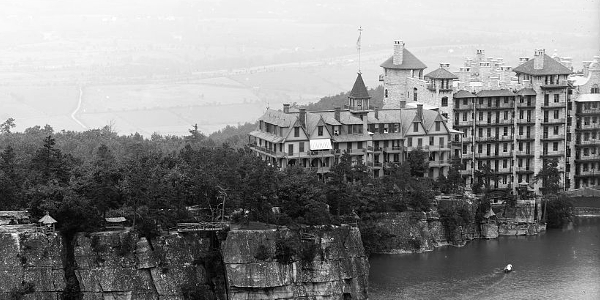How Mohonk Mountain House influenced U.S.-Indian affairs
The Friends of the Indian Conferences hosted at the resort shaped American policy toward Native peoples
by Rethinking Place Post Baccalaureate Fellow Olivia Tencer
Full article published by the Times Union. November 26th, 2023.
Image above: Mohonk Mountain House from the Sky Top Path, 1900-6, Detroit Publishing Company. Courtesy Library of Congress.
The 154-year-old Mohonk Mountain House, a luxurious resort and spa on the Shawangunk Ridge, has been in the Smiley family for five generations and is one of the most popular tourist destinations in the Hudson Valley. On-site visitors can learn about Mohonk’s history as a family business that tries to make guests feel at home. But visitors will not find a history tour, or even an acknowledgment on Mohonk’s website, about the resort’s history as the site of the yearly Lake Mohonk Friends of the Indian Conference (LMC) between 1883 and 1916, which helped shape U.S. policy for Native peoples during a time of cultural genocide and dispossession.
In 1879, a decade after Hicksite Quaker and educator twins Albert and Alfred Smiley purchased the Mountain House, President Rutherford B. Hayes appointed Albert Smiley as a member of the Board of Indian Commissioners.
Like many other Quakers of the 19th century, Albert Smiley concerned himself with the social, economic and political conditions of those deemed inferior, uncivilized and other. As scholar Carlos Figueroa writes, “…pragmatic Quakerism seemed to afford a voice for both sides of the ideological and political cultural divide on U.S. imperialism while accepting the notion of Anglo-Saxon race superiority.” Smiley’s beliefs emboldened him to get involved with the U.S. Indian boarding school system in the late 19th and early 20th centuries, which stole Native children and stripped them of aspects of their identities.
Redlands Area Historical Society
At a Board of Indian Commissioners meeting in 1882, Smiley invited members to Mohonk Mountain House. This would be the pretense for the annual conference focusing on what was then called the “Indian problem.” The conferences, as a whole, discussed policies to assimilate Native people into Euro-American society and dispossess them of their lands. To ensure the “productivity” of those in charge of finding solutions to the “Indian problem” and to exert clear religious influence, Smiley screened all members and decided which topics would be discussed.
Full article published by the Times Union. November 26th, 2023.
